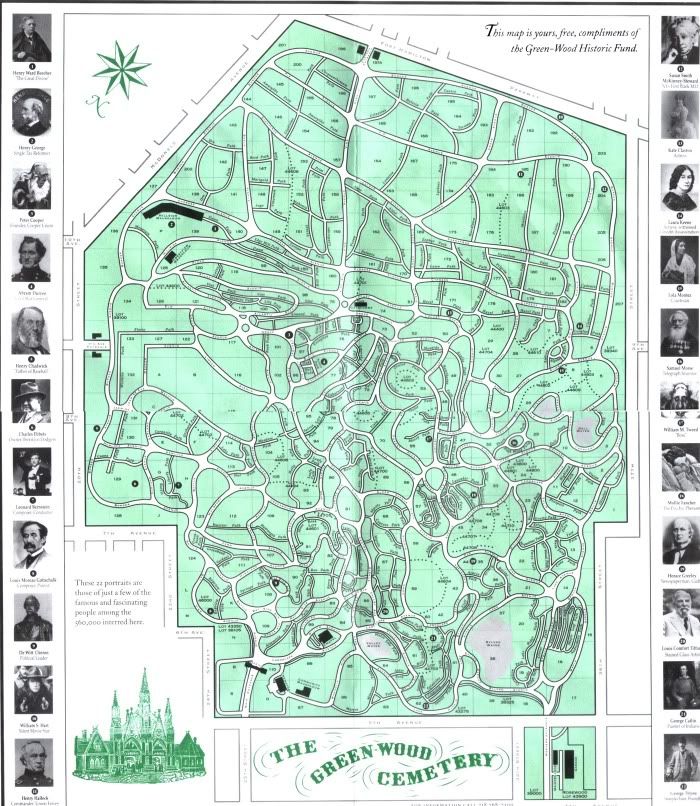 I host my images at photobucket. Clicking on the image will enlarge it, but not enough to view the details, since photobucket trims large images (as this scanned one was originally). Suffice to say (that's some mean pseudo language) getting the free map from Green-Wood will show you many of its famous "interns."
I host my images at photobucket. Clicking on the image will enlarge it, but not enough to view the details, since photobucket trims large images (as this scanned one was originally). Suffice to say (that's some mean pseudo language) getting the free map from Green-Wood will show you many of its famous "interns."Some interns are infamous, like Bill, the Butcher, Poole. From Brooklynrail.com:"Requiem for Bill"The Butcher" Poole by Carola Mandelbaum April 2003 A tall Marine with a face of Ireland played "Taps," but the freezing winds from the East River blew the music away. It was a somber ceremony. Yet after 150 years of anonymity, Bill "The Butcher" Poole had finally gotten some recognition. In mid-February a six-foot three gray tombstone was unveiled in Greenwood Cemetery in Brooklyn, on the previously unmarked gravesite of one of the meanest villains in New York’s history. There’s nothing like an Oscar-nominated blockbuster to revive a dead man’s reputation.The film, of course, is Martin Scorsese’s epic Gangs of New York, in which Daniel Day-Lewis’ interpretation of Poole figures prominently. Never mind that Poole died nearly a decade before the events of the film transpired— Hollywood has the power to create heroes that never were. For more than a century, "The Butcher" was an obscure character of a best-forgotten period of New York’s antebellum history, but these days he has been reborn as a hottest spot in the $12 walking tour of Greenwood Cemetery. Richard Moylan, president of the cemetery, poignantly unveiled the tombstone that reads the rogue’s alleged last words, "Goodbye Boys, I die a true American." According to a New York Times article from 1855, the year of his death, Poole in his last breath was heard to add "what grieves me most is thinking that I’ve been murdered by a set of Irish." Yet for officials at Greenwood Cemetery the installation of the tombstone marked "a special day in which we do a service to history, we mark this spot as a space of history. The final honoring of heroes," says Jeff Richman, the cemetery’s historian.In fact, "The Butcher" was the head of a gang of native-born Americans with decidedly anti-immigrant sentiments. Poole was known as "The Butcher" not so much for his occupation and meat shop, which he inherited from his father, but for the bloodiness of his actions. Always ready for a fight, he was ruthless with both strangers and friends. The murdering scoundrel, who died from severe bullet wounds on March of 1855, was feared in The Five Points area of Lower Manhattan and beyond. Like other notorious criminals who gained celluloid popularity many years after their demise— Butch Cassidy, comes to mind— Poole was buried in ignominy and obscurity. Gangs of New York introduced historical inaccuracies to support the creation of the character of Poole. To begin with, his artistic name is appropriately Bill Cutting— as in cutting pork chops and human limbs— and in the movie, his life has been charitably prolonged for eight additional years to keep him alive for the Draft Riots. But Tyler Anbinder, author of the 2000 book Five Points, notes that even if some historical details portrayed in the movie are not accurate, they are in fact inspired by history. "Poole is not the first person I would have honored but anything that gets people interested in history is a good thing," says Anbinder. "Seeing your work brought to life is always an exciting thing." And a popular draw for spectators, apparently. "We expect people who come to visit the museum to be enthusiastic about visiting his grave site," says Richman. Addressing the controversy of honoring Poole, Richman explains, "He shouldn’t be treated like a hero; he is, though, a historical figure." It’s a fair bet that Poole would be pleased that his renown has grown at another bloody time in New York City history, one in which immigrant groups are again being targeted. The presence at his funeral of the bugler from the Emerald Isle, of course, would be another matter entirely.
Here's a slide show of some of the infamous of Green-Wood
And BTW, here at last is Laura Nyro's "And When I Die"






No comments:
Post a Comment